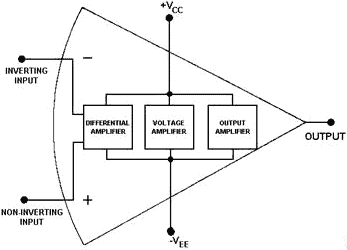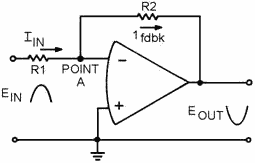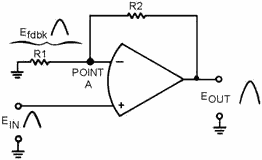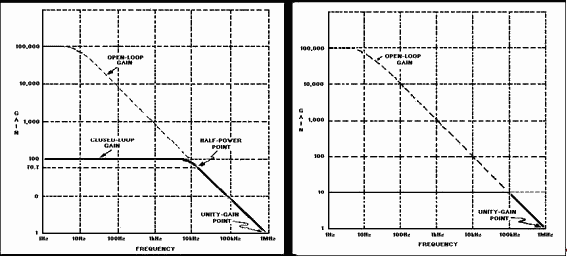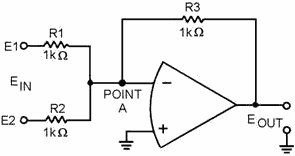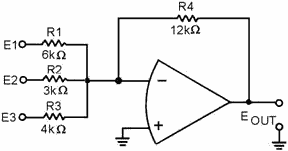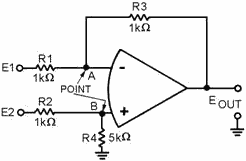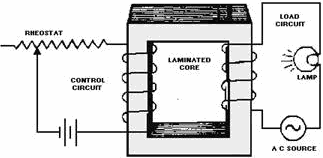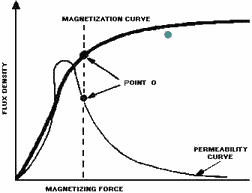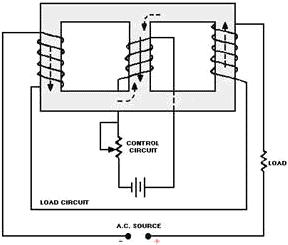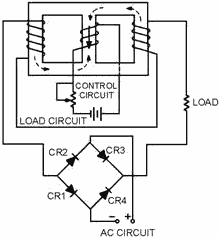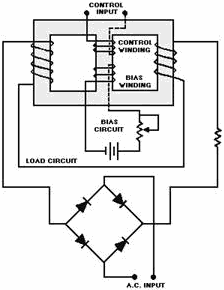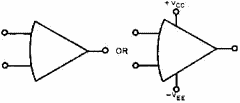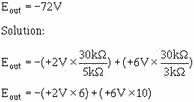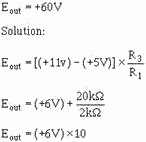Module 8 - Introduction to Amplifiers |
||||||||||||||||||||||||||||||||||||||||||||||||||
|
Module 8 − Introduction to Amplifiers Pages i, 1−1, 1−11, 1−21, 1−31, 2−1, 2−11, 2−21, 2−31, 3−1, 3−11, 3−21, 3−31, 3−41, 3−51, 3−61, AI−1, Index
Operational amplifiers are usually used in a Closed-Loop Operation. This means that degenerative feedback is used to lower the gain and increase the stability of the operational amplifier. An operational amplifier circuit can be connected with an Inverting Configuration
or a Noninverting Configuration. 3-61
The Gain-Bandwidth Product for an operational amplifier is computed by multiplying the gain by the bandwidth (in hertz). For any given operational amplifier, the gain-bandwidth product will remain the same regardless of the amount of feedback used.
A SUMMING Amplifier is an application of an operational amplifier in which the output signal is determined by the sum of the input signals multiplied by the gain of the amplifier:
3-62
A SCALING Amplifier is a special type of summing amplifier with the output signal determined by multiplying each input signal by a different factor (determined by the ratio of the input- signal resistor and feedback resistor) and then adding these products:
A Difference Amplifier is an application of an operational amplifier in which the output signal is determined by the difference between the input signals multiplied by the gain of the amplifier:
3-63
A Saturable-CORE Reactor works upon the principle that increasing the current through a coil decreases the permeability of the core; the decreased permeability decreases the inductance of the coil which causes an increase in current (power) through the load.
The IDEAL OPERATING Point of a saturable-core reactor is on the KNEE of The MAGNETIZATION Curve. At this point, small changes in control current will cause large changes in load current (power). 3-64
THREE-LEGGED and TOROIDAL saturable-core reactors solve the problem of load flux aiding and opposing control flux during alternate half cycles of the a.c. load current.
Magnetic Amplifiers use the principle of electromagnetism to amplify signals. They are power amplifiers with a frequency response normally limited to 100 hertz or below. Magnetic amplifiers use a saturable-core reactor. a magnetic amplifier uses a RECTIFIER to solve the problem of HYSTERESIs LOSS in a saturable-core reactor. 3-65
A BIAS WINDING allows a d.c. bias voltage to be applied to the saturable-core reactor while a.c. control signals are applied to a separate control winding. In this way a magnetic amplifier can be set to the proper operating point.
3-66 Answers to Questions Q1. Through Q50. A-1. Two inputs, two outputs. A-2. Common emitter (CE) and common base (CB). A-3. No output (the signals will "cancel out"). A-4. Equal in shape and frequency to each input signal and larger in amplitude by two times than either input signal. A-5. Equal in shape and frequency to the input signal; larger in amplitude than the input signal; half as large in amplitude as when two input signals were used that were 180 degrees out of phase. A-6. a different shape than the input signals but larger in amplitude. A-7. 100 millivolts. A-8. Each output will be a sine wave with a peak-to-peak amplitude of 100 millivolts. The output signals will be 180 degrees out of phase with each other. A-9. 200 millivolts. A-10. 0 volts (the input signals will "cancel out"). A-11. Each output signal will be 100 millivolts. A-12. a. 180 degrees out of phase with each other. b. Output signal number one will be in phase with input signal number two; output signal number two will be in phase with input signal number one. A-13. 200 millivolts. A-14. a. 100 millivolts. b. No. A-15. Very high gain, very high input impedance, very low output impedance. A-16. An integrated circuit (chip). 3-67 A-17.
A-18. a. Differential amplifier. b. Voltage amplifier. c. Output amplifier. A-19. The use of degenerative (negative) feed-back. A-20. Both the input signal and the feedback signal. A-21. a. Inverting. b. Inverting. A-22. 0 volts. A-23. Virtual. A-24. -50 millivolts. A-25. 50 kilohertz (Gain = 10; Gain-Bandwidth Product = 500,000;
A-26. 60 millivolts. 3-68 A-27. 1 megahertz. Open-loop Gain-Bandwidth Product = Closed-loop Gain-Bandwidth Prod. Open-loop Gain-Bandwidth Product = 200,000 ´ 30 (Hz) Open-loop Gain Bandwidth Product = 600,000 Closed-loop Gain Bandwidth Product = 6 ´ Bandwidth 6,000,000 = 6 ´ Bandwidth 1,000,000 (Hz) = Bandwidth A-28. The adder simply adds the input signals together while the summing amplifier multiplies the sum of the input signals by the gain of circuit. A-29. Yes, a summing amplifier can have as many inputs as desired. A-30. a summing amplifier that applies a factor to each input signal beforeadding the results. A-31. a scaling amplifier. A-32.
A-33. 0 volts. (The two inputs to the operational amplifier are both at 0 volts.) A-34. The difference amplifier multiplies the difference between the two inputs by the gain of the circuit while the subtractor merely subtracts one input signal from the other. A-35. No. A-36. a difference amplifier. 3-69 A-37.
A-38. 0 volts. (The two inputs to the operational amplifier are both at the same potential.) A-39. An audio (or low) frequency power amplifier. A-40. a change in inductance in a series LR circuit causes a change in true power. A-41. It decreases. A-42. (a) Inductance increases; (b) true power decreases. A-43. Permeability decreases. A-44. a change in inductance. A-45.
A-46. The knee of the curve. A-47. use two load windings whose flux effects cancel in the core of the reactor or use two load windings on two toroidal cores so that load flux always aids control flux in one core and opposes control flux in the other core. A-48. The rectifier eliminates hysteresis loss.
A-49. a bias winding and associated circuitry. A-50. Servosystems, temperature recorders, or power supplies. 3-70 |
||||||||||||||||||||||||||||||||||||||||||||||||||
